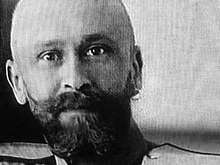Nikolai Stogov
Nikolai Nikolayevich Stogov (September 10, 1873 – December 7, 1959) was a Russian general who fought in the First World War and Russian Civil War.
Nikolai Stogov | |
|---|---|
 | |
| Born | September 10, 1873 |
| Died | December 7, 1959 (aged 86) Sainte-Geneviève-des-Bois, Essonne, France |
| Allegiance | Russian Empire Russian Soviet Federative Socialist Republic |
| Service/ | Imperial Russian Army Red Army |
| Rank | lieutenant general |
| Commands held | Southwestern Front |
| Battles/wars | World War I Russian Civil War |
Biography
He graduated from Nicholas Cadet Corps, Konstantinovskoe Artillery School and joined the Volinsky Life-Guards Regiment. In 1900, he graduated from General Staff Academy as "first-class", earning the right to accelerated promotion. In November 1900, he held the post of senior adjutant of the 17th Infantry Division, and in May 1901, he served as a superior officer for special assignments at the 6th Army Corps Headquarters; from September 1904 to March 1909, as a senior adjutant of the Warsaw Military District headquarters. In December 1908, he was promoted to the rank of colonel, and in May 1909, he was appointed head of the Office of Military History in the Division of General Quartermaster General Headquarters.[1][2] Since July 14, 1910, the MDGs clerk.
First World War
At the start of the war in 1914, he was chief of staff of the 1st Finnish Rifle Brigade. In the fall of 1914, he was appointed commander of the 3rd Finnish Rifle Regiment. On 15 April 1915, the General Quartermaster headquarters of the 8th Army of Brusylov was appointed. On September 25, 1916, he was appointed chief of Staff of the 8th Army. He was the closest assistant to Generals Aleksei Brusilov and Alexey Kaledin. After the February revolution, he was rapidly promoted. On April 2, 1917, he became commander of XVI Army Corps and was promoted to Lieutenant General on 29 April 1917. After the statement by General Lavr Kornilov, on 10 September 1917, he replaced General Sergey Markov as Chief of staff of the armies of the Southwestern Front. After the October Revolution, he served as commander-in-chief of the front armies for some time.
Russian Civil War
In January 1918, Stogov joined the Red Army. From 8 May to 2 August 1918, he was chief of Red Army Headquarters (one of two it had) – Vserosglavshtab. In October-November 1918, Stogov was arrested by Cheka. From November 25, 1918 works in the Central Archive system. Since February 1, 1919, he is an assistant manager in the 1st Moscow Branch of the 3rd (military) section of the Central Archive. Cooperated with the Anti-Bolshevik underground Organization National Centre, participated in the clandestine headquarters of the anti-government Volunteer Army of the Moscow district; since April 1919, Commander-in-Chief of the Volunteer Army of the Moscow District. In April 1919, again arrested by Cheka. He was held in Butyrskaya prison and Andronikov Monastery. In the fall of 1919, he escaped from detention.[3] He fled to Poland, where he came to the White Movement in the south of Russia. In the White Movement, served as the Chief of Staff of the Kuban Army of VSUR at General Andrei Shkuro, January-February 1920. Since May 1920, the commander of Sevastopol in the Russian army general Wrangel; at the same time, the commander of the rear area troops.
In exile
After the evacuation, he lived in Zemun (Yugoslavia) for several years, from 1924 moved to Paris, where he worked at the factory. Since 1928, deputy chief, and since 6 July 1930, chief of the Military chancellery of Russian All-Military Union (until 1934). Since 1948 vice-chairman of the Committee of the Guards Association, collaborated in the Hour magazine. He died in the Russian retirement house in Sainte-Geneviève-des-Bois, Essonne.
Awards
- Order of Saint Stanislaus (House of Romanov), 3rd class, 1904
- Order of Saint Stanislaus, 2nd class, 1906
- Order of Saint Vladimir, 4th class (July 19, 1910)
- Gold Sword for Bravery (June 10, 1915)
- Order of Saint George, 4th degree (June 14, 1915)
- Order of Saint Stanislaus, 1st class (April 10, 1916)
- Order of Saint Anna, 1st class (August 9, 1916)
| Preceded by Nikolai Volodenko |
Commander of the Southwestern Front November–December 1917 |
Succeeded by Vladimir Yegoryev |
| Preceded by office created |
Chiefs of the All-Russian Main Staff of the Revolutionary Military Council of the Republic May 1918 – August 1919 |
Succeeded by Alexander Andreyevich Svechin |
References
- Адрес-календарь. Общая роспись начальствующих и прочих должностных лиц по всем управлениям в Российской империи на 1910 год (Инспекторский отд. собств. Е. И. В. канцелярии ed.). СПб.: Сенатская тип. 1910. p. 889.
- Пучкова О. А., Иванов Д. Д. (2008). "Военно-учёный архив: краткий очерк формирования ценнейших коллекций" (1) (Вестник архивиста ed.). М.: РОИА: 29. ISSN 2073-0101. Cite journal requires
|journal=(help) - Российская газета. Последний комендант Севастополя